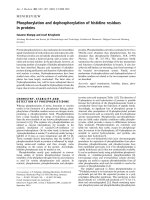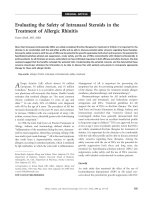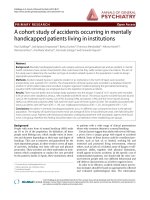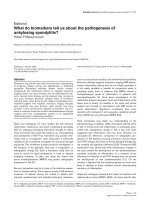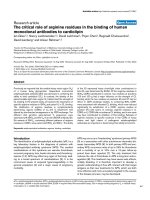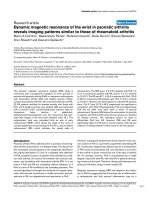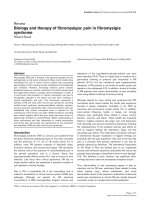Báo cáo y học: "What do measurements of molecular biomarkers in different body fluids really tell us" doc
Bạn đang xem bản rút gọn của tài liệu. Xem và tải ngay bản đầy đủ của tài liệu tại đây (122.38 KB, 2 trang )
e ability to accurately monitor changes in joint meta-
bo lism in vivo that may lead to and predict, at a much
later date, onset of structural pathology detected by
imaging is an important challenge for osteoarthritis (OA)
biomarker research. A recent study has examined very
early molecular biomarker changes in synovial fl uid (SF),
sera and urine following anterior cruciate ligament
rupture [1]. is damage often leads, many years later, to
the onset of OA. In animals, such an injury can result in
OA onset within weeks [2]. As the joint is considered the
focus of the pathology, it is important to determine
whether analyses of more accessible body fl uids (urine
and serum) refl ect biomarker changes in OA joints. SF,
serum and urine samples were taken from 11 patients on
two consecutive occasions approximately 15 and 47 days
after rupture. Twenty-one diff erent biomarkers were
analysed but seven were restricted to SF measures only.
Previously, most biomarker studies – with some excep-
tions [3] – examined one or two biomarkers of special
interest and availability, often in only one body fl uid. e
study of Catterall and colleagues is therefore helpful in
that it sought to gain a broader picture of biomarker
changes and their interrelationships between fl uids [1].
e declines in SF proteoglycan glycosaminoglycan
and aggrecan cleavage neoepitope contents contrasted
with an increase in biomarkers of type I collagen degra-
dation, namely CTx1, NTx, C1,2C (the latter also detects
type II collagen cleavage), and the cartilage type II
collagen cleavage biomarker CTxII, now known to be
mainly generated by type II cleavage in calcifi ed cartilage
[4]. But the authors’ claims that these proteoglycan and
collagen changes refl ect what is seen in vitro when
cartilage degradation is stimulated [1] are debateable,
particularly since the most signifi cant collagen changes
involved mainly type I collagen. One must also question
the con clusion that these biomarkers ‘demonstrated that
there is signifi cant and measurable cartilage and bone
damage after acute knee injury’. No such changes were
shown clinically.
Some of the most interesting data in this paper come
from asking whether biomarkers in body fl uids refl ect
primarily joint-derived sources. e much increased
contents in SF over serum of aggrecan FA846, COMP
and MMP3 point to a joint origin for these biomarkers.
But there is only a correlation between serum and SF for
MMP3, and then it is rather weak. It may therefore be
better to look at these biomarkers in SF rather than in
serum.
In contrast, the serum/urine bone biomarkers CTx1,
NTx and osteocalcin show strong correlations with SF.
None of these biomarkers are really elevated in SF
(1.6-fold, 1.2-fold and 1.2-fold, respectively), however,
suggest ing that they arise primarily systemically, thereby
explaining these correlations. If the biomarkers do arise
Abstract
Molecular or biochemical biomarkers of joint
metabolism o er promise in helping us understand
joint pathology, its detection and treatment. But they
have often been studied alone and in only one body
uid. Although the synovial joint is usually the focus of
most arthritis pathology, it is often di cult, for a variety
of reasons, to obtain synovial uid that should best
re ect changes in biomarkers related to pathology. It
is therefore very important to see whether analyses
of more readily obtainable sera and urine also re ect
changes in synovial uid. Catterall and colleagues, in a
paper in Arthritis Research & Therapy that examines very
early biomarker changes following joint injury, provide
us with some insights into these important questions.
As the study was very small and examined very early
changes following joint injury, prior to onset of any
recognisable pathology, we look forward to future
larger biomarker studies of this kind in patients with
clinically de ned arthritic changes to which we can
relate biomarker data.
© 2010 BioMed Central Ltd
What do measurements of molecular biomarkers
in di erent body uids really tell us?
A Robin Poole*
See related research by Catterall et al., />EDITORIAL
*Correspondence:
Department of Surgery, 687 Pine Avenue West, McGill University, Montreal,
Quebec H3A 1A1, Canada
Poole Arthritis Research & Therapy 2011, 13:110
/>© 2011 BioMed Central Ltd
system a tically, then this would indicate more systemic
changes in bone metabolism. Uninjured and nonarthritic
controls are needed to help answer such questions.
An analysis of the interrelationships and possible
correlations between bone, cartilage and infl ammation
metabolism refl ected by biomarkers is invariably useful
but was overlooked. Not only are the eff ects of infl am-
mation important to understand, but also whether bone
changes accompany early changes in cartilages as
suggested above. Analyses of data for ratios between
biomarkers, such as those of matrix turnover/synthesis
and degradation, were also lacking. ese insights into
the balance between synthesis and degradation can
provide valuable additional information [5,6].
Earlier work by Kraus and colleagues pointed to the
importance of relating measurements in SF to urea to
correct for dilutions caused by joint eff usions [7]. Yet this
correction was not applied by Catterall and colleagues.
Are such corrections not necessary?
e present discussion of this study by Catterall and
colleagues [1] has provided important but sobering
insights and reminders – we should exercise great
caution in how we interpret biomarker data, and should
endeavour to make sure we understand what the data
mean. Until we have defi nitive indications that given
changes in bio markers in a given body fl uid do indeed
consistently refl ect specifi c clinical changes, we must
avoid putting any reliance on biomarker data alone. We
are still in an exploratory/assessment phase in our
understanding of what molecular biomarkers can really
off er us. We have often seen that measurements in sera
or urine may have no relationship to events measured in
joints. e study population was very small, asking too
much of statistical analyses, and often only SFs were
examined [1]. Studies were made of early events long
before any degenerative structural changes would be
expected, to which we could relate and make sense of the
biomarker data. What we need are future clinical studies
assessing head to head many diff erent biomarkers and
diff erent body fl uids, as in this investigation. But in
addition we must have structural joint changes in bone
and cartilage to which we can relate.
Biomarker analyses alone are no longer the way to go.
ankfully the private/public OA initiative launched by
the NIAMS/NIH and industry – now involving the
expertise off ered by the Osteoarthritis Research Society
International – is one exercise that should provide us
with momentum in better understanding biomarkers of
diff erent kinds.
Abbreviations
OA, osteoarthritis; SF, synovial uid.
Competing interests
ARP is a consultant to IBEX, Montreal, Canada.
Published: 27 April 2011
References
1. Catterall JB, Stabler TS, Flannery CR, Kraus VB: Changes in serum and
synovial uid biomarkers after acute injury. Arthritis Res Ther 2010, 12:R229.
2. Poole AR, Blake S, Buschmann M, Goldring S, Laverty S, Lockwood S, Matyas J,
McDougall J, Pritzker K, Rudolphi K, van den Berg W, Yaksh T:
Recommendations for the use of preclinical models in the study and
treatment of osteoarthritis. Osteoarthritis Cartilage 2010, 18:S10-S16.
3. Cibere J, Zhang H, Garnero P, Poole AR, Lobanok T, King L, Saxne T, Kraus VB,
Way A, Thorne A, Wong H, Singer J, Kopec J, Guermazi A, Peterfy C, Nicolaou
C, Munk P, Esdaile JM: Association of biomarkers with pre-radiographically
de ned and radiographically de ned knee osteoarthritis in a population-
based cohort. Arthritis Rheum 2009, 60:1372-1380.
4. Bay-Jensen AC, Andersen TL, Charni-Ben Tabassi N, Kristensen PW,
Kjaersgaard-Andersen P, Sandell L, Garnero P, Delaisse JM: Biochemical
markers of type II collagen breakdown and synthesis are positioned at
speci c sites in human osteoarthritic knee cartilage. Osteoarthritis Cartilage
2008, 16:615-623.
5. Cahue S, Sharma L, Dunlop D, Ionescu M, Song J, Lobanok T, King L, Poole AR:
The ratio of type II collagen breakdown to synthesis and its relationship
with the progression of knee osteoarthritis. Osteoarthritis Cartilage 2007,
15:819-823.
6. Garnero P, Ayral X, Rousseau JC, Christgau S, Sandell LJ, Dougados M, Delmas
PD: Uncoupling of type II collagen synthesis and degradation predicts
progression of joint damage in patients with knee osteoarthritis. Arthritis
Rheum 2002, 46:2613-2624.
7. Kraus VB, Huebner JL, Fink C, King JB, Brown S, Vail TP, Guilak F: Urea as a
passive transport marker for arthritis biomarker studies. Arthritis Rheum
2002, 46:420-427.
doi:10.1186/ar3276
Cite this article as: Poole AR: What do measurements of molecular
biomarkers in di erent body uids really tell us? Arthritis Research & Therapy
2011, 13:110.
Poole Arthritis Research & Therapy 2011, 13:110
/>Page 2 of 2

